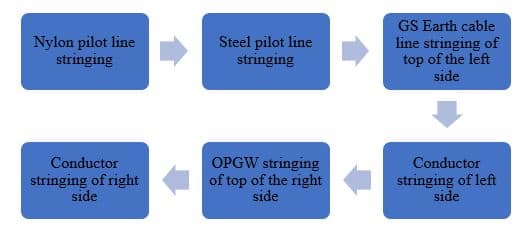Stringing Operation
Stringing Operation is basically identified as the installation of overhead conductors. You can find four main types of Stringing Operations for instance,
- Tension Method
- Semi – Tension Method
- Layout Method
- Slack Method
This article mainly focuses on the tension method. In the tension method, during the stinging operation conductors are kept under tension and keep the ground clearance to prevent damage to conductors and clear of energized circuits. Normally there are five lines of stringing.
Tension Method of Stringing
The tensioner method of the Stringing is show operation due to the Stringing of the pilot line and final conductor cable. Similarly, the operation team very carefully about conductors to prevent damages while stringing. There are Nylon pilot, Steel pilot, GS Earth wire, ACSR zebra conductor, and OPGW use for 132kV transmission line in Sri Lanka. The following procedure can use for stringing. The special design of “Tensioner” and “Puller” use for the stringing operation.
Steps of Tension Method Stringing

The first-line used for stringing conductors, GS earth wire, or OPGW is the Nylon pilot line since they cannot be strung without it. The nylon pilot line stringing by hand for the first time. Then Steel pilot line can attach to the Nylon pilot line using “Swivel Joint”. When this happens there is a tensioner and a puller at both ends of the Stringing section. After the stringing of the Steel pilot line, Galvanize Steel Earth cable or OPGW can attach using conductor shock and swivel joint. Conductor shock is normally attaching to the GS earth cable.
Normally stringing carried out from top to bottom because otherwise, conductors will be rubbing each other, and the surface of the conductors get damage.
After the string of Nylon pilot line as usually attach the steel pilot rope. for stringing of the ACSR Zebra conductor to the steel rope using a swivel joint and conductor shock. Follow the same procedure until finish the six conductors, GS earth wire, and OPGW cable stringing. After stringing of cables can attach to tower using come along clams.
OPGW stringing is much different than conductor cable and Earth wire stringing. That is a very slow operation and very responsible operation because OPGW can get damage.
During the stringing operation normally use “Running Earth” that can attach to both the tensioner, puller, and Ground. Cables become energized sometimes before and during rainy conditions or in the presence of rain clouds. As a safety procedure running earth is a must.
Tools and Equipment Used in Stringing Operation.
Following tools and equipment normally use for stringing.
- Overhead line Conductor Tensioner
- Overhead line Conductor Puller
- Motorized Winches
- Conductor reel stands
- Conductor stringing blocks
- Come along clamps
- Conductor cutter
- Fixed and swivel joints


Over Head Line Conductor Tensioner
The machine uses a diesel engine system to operate the hydraulic pump and hydraulic system for the overhead transmission line stringing.

Over Head Line Conductor Puller
The machine, known as the Tensioner, is equipped with a diesel engine that powers the hydraulic system. It is specifically designed for running the hydraulic system. There is an automatic winding system in that machine for pilot rope winding on the reel.

This article mainly based on Tension Method Stringing Operation with on-site experience in Sri Lanka and hope you get some knowledge about tower erection.
Really appreciate your taking the time to read the article. Feel free to add some comments here and share your knowledge with us.



0 Comments